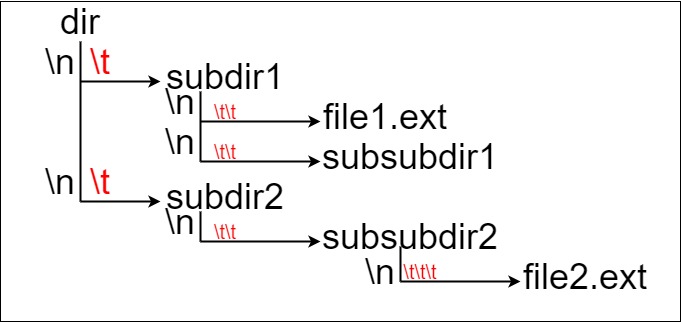LeetCode-in-Java
388. Longest Absolute File Path
Medium
Suppose we have a file system that stores both files and directories. An example of one system is represented in the following picture:

Here, we have dir as the only directory in the root. dir contains two subdirectories, subdir1 and subdir2. subdir1 contains a file file1.ext and subdirectory subsubdir1. subdir2 contains a subdirectory subsubdir2, which contains a file file2.ext.
In text form, it looks like this (with ⟶ representing the tab character):
dir
⟶ subdir1
⟶ ⟶ file1.ext
⟶ ⟶ subsubdir1
⟶ subdir2
⟶ ⟶ subsubdir2
⟶ ⟶ ⟶ file2.ext
If we were to write this representation in code, it will look like this: "dir
\tsubdir1
\t\tfile1.ext
\t\tsubsubdir1
\tsubdir2
\t\tsubsubdir2
\t\t\tfile2.ext". Note that the '
' and '\t' are the new-line and tab characters.
Every file and directory has a unique absolute path in the file system, which is the order of directories that must be opened to reach the file/directory itself, all concatenated by '/'s. Using the above example, the absolute path to file2.ext is "dir/subdir2/subsubdir2/file2.ext". Each directory name consists of letters, digits, and/or spaces. Each file name is of the form name.extension, where name and extension consist of letters, digits, and/or spaces.
Given a string input representing the file system in the explained format, return the length of the longest absolute path to a file in the abstracted file system. If there is no file in the system, return 0.
Example 1:

Input: input = “dir\n\tsubdir1\n\tsubdir2\n\t\tfile.ext”
Output: 20
Explanation: We have only one file, and the absolute path is “dir/subdir2/file.ext” of length 20.
Example 2:

Input: input = input = “dir\n\tsubdir1\n\t\tfile1.ext\n\t\tsubsubdir1\n\tsubdir2\n\t\tsubsubdir2\n\t\t\tfile2.ext”
Output: 32
Explanation: We have two files: “dir/subdir1/file1.ext” of length 21 “dir/subdir2/subsubdir2/file2.ext” of length 32. We return 32 since it is the longest absolute path to a file.
Example 3:
Input: input = “a”
Output: 0
Explanation: We do not have any files, just a single directory named “a”.
Example 4:
Input: input = “file1.txt
file2.txt
longfile.txt”
Output: 12
Explanation: There are 3 files at the root directory. Since the absolute path for anything at the root directory is just the name itself, the answer is “longfile.txt” with length 12.
Constraints:
1 <= input.length <= 104inputmay contain lowercase or uppercase English letters, a new line character' ', a tab character'\t', a dot'.', a space' ', and digits.
Solution
import java.util.ArrayDeque;
import java.util.Deque;
public class Solution {
public int lengthLongestPath(String input) {
Deque<Integer> stack = new ArrayDeque<>();
int longestLen = 0;
int currDirLen = 0;
int i = 0;
int currLevel;
int nextLevel = 0;
boolean isFile = false;
Character period = '.';
Character space = ' ';
while (i < input.length()) {
currLevel = nextLevel;
int currStrLen = 0;
while (i < input.length()
&& (Character.isLetterOrDigit(input.charAt(i))
|| period.equals(input.charAt(i))
|| space.equals(input.charAt(i)))) {
if (period.equals(input.charAt(i))) {
isFile = true;
}
i++;
currStrLen++;
}
if (isFile) {
longestLen = Math.max(longestLen, currDirLen + currStrLen);
} else {
currDirLen += currStrLen + 1;
stack.push(currStrLen + 1);
}
nextLevel = 0;
// increment one to let it pass "\n" and start from "\t"
i = i + 1;
while (i < input.length() - 1 && input.charAt(i) == '\t') {
nextLevel++;
i = i + 1;
}
if (nextLevel < currLevel) {
int j = 0;
if (isFile) {
while (!stack.isEmpty() && j < (currLevel - nextLevel)) {
currDirLen -= stack.pop();
j++;
}
} else {
while (!stack.isEmpty() && j <= (currLevel - nextLevel)) {
currDirLen -= stack.pop();
j++;
}
}
} else if (nextLevel == currLevel && !isFile && !stack.isEmpty()) {
currDirLen -= stack.pop();
}
if (nextLevel == 0) {
currDirLen = 0;
stack.clear();
}
isFile = false;
}
return longestLen;
}
}

